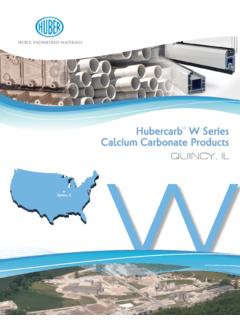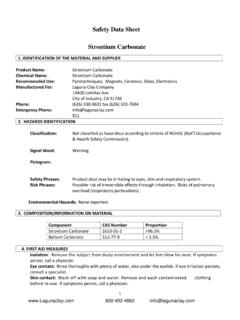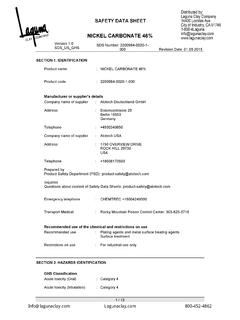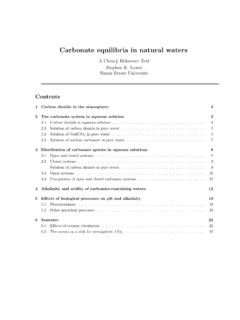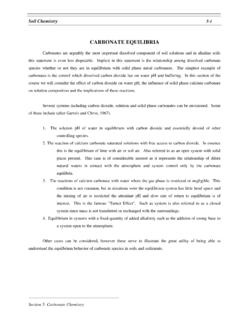Transcription of Safety Data Sheet – Sodium Carbonate, Anhydrous
1 Page 1 of 9 Safety data Sheet Sodium Carbonate, Anhydrous Date Reviewed: February 2015 Supersedes: January 2015 This document has been prepared to meet the requirements of the OSHA Hazard Communication Standard, 29 CFR ; the Canada s Workplace Hazards Materials Information System (WHMIS) and, the EC Directive, 2001/58/EC. 1. Product and Company Identification Product Name Sodium Carbonate, Anhydrous Alternate Product Name(s) Soda Ash, Disodium Carbonate Also: Dense Soda Ash, Soda Ash Light, Synthetic Light Soda Ash, Soda Ash Liquid, Natural Light Soda Ash, Natural Light HA Soda Ash Chemical Formula Na2CO3 Product Use Glass manufacture, detergent manufacture, Sodium chemicals and carbonate chemicals manufacture, pulp and paper, brine treatment, water hardness removal, pH adjustment in water or wastewater, flue gas desulphurization, coal treatment, ion exchange resin regeneration. This chemical is certified to ANSI/NSF Standard 60, Drinking Water Chemicals Health Effects (as packaged in the original, unopened container).
2 Concentration not to exceed 100 ppm when used for corrosion control or scale control pH adjustment. Manufacturer Tata Chemicals (Soda Ash) Partners 100 Enterprise Drive Rockaway, NJ 07866 Emergency Telephone Numbers (800) 424-9300 (CHEMTREC US) (613) 996-6666 (CANUTEC Canada) (307) 872- 3431 (Plant Green River, WY) 2. Hazards Identification Emergency Overview: White, odorless, granular solid. Product is non-combustible. Reacts with acids to release carbon dioxide gas and heat. May irritate skin and eyes. Dusts may irritate respiratory tract. Not expected to be toxic to the environment, nor to aquatic organisms. Avoid simultaneous exposure to soda ash and lime dust. In the presence of moisture ( perspiration) the two materials combine to form caustic soda (NaOH), which may cause burns. Hazard Classification: Class Category Hazard Statement Page 2 of 9 Eye Irritant Category 2 H319 Causes serious eye irritation EC Labeling Name of substance to appear on label.
3 Sodium Carbonate Symbol(s) Xi irritating Label Phrases R36: Irritating to eyes. S2: Keep out of reach of children. S22: Do not breathe dust. S26: In case of contact with eyes, rinse immediately with plenty of water and seek medical advice. Potential Health Effects: Skin Prolonged contact may cause skin irritation (red, dry, cracked skin). Eyes Irritating to the eyes. Ingestions Although low in toxicity, ingestion may cause nausea, vomiting, stomach ache, and diarrhea. Inhalation Prolonged inhalation of product dusts may irritate nose, throat, and lungs. Chronic Effects Excessive, long term contact may produce soda ulcers on hands and perforation of the nasal septum. Sensitivity reactions may occur from prolonged and repeated exposure. This product does not contain any ingredient designated by IARC, NTP, ACGIH or OSHA as probable or suspected human carcinogens. 3. Composition / Information on Ingredients Chemical Name CAS # Wt.
4 % EC No. EC Class Sodium Carbonate 497-19-8 207-838-8 Xi, R36 4. First Aid Measures Skin Wash with plenty of soap and water. Get medical attention if irritation occurs and persists. Remove and wash contaminated clothing before re-use. Eyes Immediately flush with water for at least 15 minutes lifting the upper and lower eyelids intermittently. See a medical doctor or ophthalmologist as necessary. Ingestions Rinse mouth with water. Dilute by giving 1 or 2 glasses of water. Do not induce vomiting. Never give anything by mouth to an unconscious person. I f s y m p t o m s p e r s i s t , contact a doctor or poison control center. Inhalation Remove to fresh air. If breathing difficulty or discomfort occurs and persists, obtain medical attention. Advice to Physician While internal toxicity is low, irritant effects of high concentrations may produce corneal opacities, and vesicular skin reactions in humans with abraded skin only.
5 Treatment is symptomatic and supportive. Page 3 of 9 5. Fire Fighting Measures Extinguishing Media: Not combustible, use extinguishing method suitable for surrounding fire. Fire/Explosion Hazards: Not applicable. Fire Fighting Procedures: Wear full protective clothing and self-contained breathing apparatus Flammable Limits: Not applicable Auto ignition Temperature: Not applicable Hazardous Combustion Products: Carbon dioxide. Sensitivity to Impact: None Sensitivity to Static Discharge: None 6. Accidental Release Measures Personal Precautions: Refer to Section 8 Exposure Controls / Personal Protection Containment: Prevent large quantities of this product from contacting vegetation or waterways; large spills could kill vegetation and fish. Clean Up: This product, if spilled, can be recovered and re-used if contamination does not present a problem. Vacuum or sweep up the material a n d c o l l e c t i n a s u i t a b l e c o n t a i n e r f o r d i s p o s a l If the spilled product is unusable due to contamination, consult state or federal environmental agencies for acceptable disposal procedures and locations.
6 See Section 13 Notification Requirements: Federal regulations do not require notification for spills of this product. State and local regulations may contain different requirements; consult local authorities. 7. Handling and Storage Handling: Use air conveying / mechanical systems for bulk transfer to storage. For manual handling of bulk transfer use mechanical ventilation to remove airborne dust from railcar, ship or truck. Use approved respiratory protection when ventilation systems are not available. Selection of respirators is based on the dust cloud generation. Keep material out of lakes, streams, ponds and sewer drains. Avoid eye contact or prolonged skin contact. Avoid breathing dusts. When dissolving, add to water cautiously and with stirring; solutions can get hot. Use good personal hygiene and housekeeping. Storage: Store in a cool dry area, away from incompatible products (acids). Prolonged storage may cause product to cake from atmospheric moisture.
7 Page 4 of 9 8. Exposure Controls / Personal Protection Engineering Controls: Where possible, provide general mechanical and/or local exhaust ventilation to prevent release of airborne dust into the work environment. Eye wash facility should be provided in storage and general work area. Personal Protective Equipment: Eyes and Face: For dusty or misty conditions, or when handling solutions where there is reasonable probability of eye contact, wear chemical Safety goggles and hardhat. Under these conditions do not wear contact lenses. Otherwise, appropriate eye and face protection equipment (ANSI Z87 approved) should be selected for the particular use intended for this material. Safety glasses with side shields are recommended. Respiratory: Whenever dust in the worker s breathing zone cannot be controlled with ventilation or other engineering means, workers should wear respirators or dust masks approved by NIOSH/MSHA, EU CEN or comparable certification organization to protect them against airborne dust.
8 Page 5 of 9 Hands, Arms, and Body: Wear long-sleeve shirt and trousers, and impervious gloves for routine product use. Cotton gloves are sufficient for dry product; wear impervious ( , rubber, neoprene, etc.) gloves when handling solutions. Protective shoes or boots. Exposure Guidelines: Federal guidelines treat the ingredient(s) in this product as a nuisance dust, as no product-specific guidelines have been issued for exposure. As with all nuisance dusts, worker breathing zone concentrations should be measured by validated sampling and analytical methods. The following limits (OSHA and MSHA) apply to this material: Particulates Not Otherwise Regulated: OSHA (PEL / TWA): 15 mg/m3 (total dust); 5 mg/m3 (rasp fraction) MSHA (PEL / TWA): 10 mg/m3 (total dust) Avoid simultaneous exposure to soda ash and lime dust. In the presence of moisture ( perspiration) the two materials combine to form caustic soda (NaOH), which may cause burns.
9 The information noted above provides general guidance for handling this product. Specific work environments and material handling practices will dictate the selection and use of personal protective equipment (PPE). 9. Physical and Chemical Properties Appearance: White, granular solid Odor: Odorless Formula: Na2CO3 Molecular Weight: Bulk Density (g/l) Dense grades: Natural light grade: Synthetic light grade: Specific Gravity: (vs. water) Boiling Point: Decomposes Melting Point: 854oC (1569oF) Evaporation Rate: Not applicable Percent Volatile: 0% Vapor Density: Not applicable Vapor Pressure: Not applicable pH (1% solution) Flash Point None 10. Stability and Reactivity Stability: Stable Conditions to Avoid: Contract with acids will release carbon dioxide, heat. Contract with lime dust in the presence of moisture can produce corrosive Sodium hydroxide. Materials to avoid May react with aluminum, acids, fluorine, lithium, and 2,4,6- Trinitrotoluene.
10 Polymerization: Will not occur. Hazardous Decomposition When heated to decomposition, carbon dioxide is released. Page 6 of 9 Products Other Precautions: When dissolving, add to water cautiously and with stirring; solutions can get hot. 11. Toxicological Information Eye: Severe irritant (50 mg, rabbit). Skin: Mild irritant (500 mg/24hr, rabbit). Minor irritation may occur on abraded skin. Not a sensitizer (tested at solution). Oral: LD50, rat: 4,090 mg/kg Inhalation: LC50, rat, 2hr mg/l 24 hour LC50: 800 mg/m3, 20 h exposure (guinea pig) (moderate toxicity) Chronic: Excessive, long term contact may produce soda ulcers on hands and perforation of the nasal septum. Sensitivity reactions may occur from prolonged and repeated exposure. Carcinogenicity: Not designated by IARC, NTP, ACGIH or OSHA as probable or suspected human carcinogens. 12. Ecological Information Acute ecotoxicity: 96 hour LC50: 265 565 mg/l (daphnia magnia) (low toxicity) 300 320 mg/l (blue gill sunfish) (low toxicity) 96 hour TLm: 1200 mg/l (mosquito-fish) 48 hour TLm: 840 mg/l (mosquito-fish) 48 hour EC50: 265 mg/l (daphnia magnia) 5 Day EC 50: 242 mg/l (Nitszcheria linearis) Chronic ecotoxicity: 7 Day EC, biomass: 14 mg/l (phytoplankton) Mobility: Air: Not Applicable Water: Considerable solubility and mobility.

